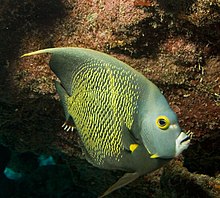French angelfish
| French angelfish | |
|---|---|

| |
| Scientific classification | |
| Domain: | Eukaryota |
| Kingdom: | Animalia |
| Phylum: | Chordata |
| Class: | Actinopterygii |
| Order: | Perciformes |
| Family: | Pomacanthidae |
| Genus: | Pomacanthus |
| Species: | P. paru
|
| Binomial name | |
| Pomacanthus paru (Bloch, 1787)
| |
| Synonyms[2] | |
| |
The French angelfish (Pomacanthus paru) is a species of marine ray-finned fish, a marine angelfish belonging to the family Pomacanthidae. It occurs in the Western Atlantic Ocean.
Description[edit]

The French angelfish has a laterally compressed body which is almost circular in shape. The head is deep with a short snout ending in a small mouth which contains numerous bristle-like teeth. There is an obvious spine at the corner of the preoperculum while there are no spines on the operculum or under the eye.[3] The dorsal fin contains 10 spines and 29-31 soft rays while the anal fin contains 3 spines and 22-24 soft rays. This species attains a maximum total length of 41.1 centimetres (16.2 in).[2] The juveniles are almost completely black apart from five vertical yellow bands the first around the mouth and the last at the caudal peduncle, the bands on the body are curved. The caudal fin has yellow margins. The adults are also mainly black but most of the scales on the body have a golden-yellow edge. They have a white mouth and a yellow orbit. The pectoral fins have a wide orange-yellow band and the dorsal fin has a long yellow filamentous extension growing from its soft-rayed part.[4]
Distribution[edit]
The French angelfish is found in the western Atlantic from New York and the Bahamas to Brazil, and also the Gulf of Mexico and the Caribbean, including the Antilles, Roatan, and the eastern Atlantic from around Ascension Island and St. Paul's Rocks.[2]
Habitat and biology[edit]
The French angelfish is found at depths between 3 and 100 m (9.8 and 328.1 ft). It is common on rocky and coral reefs where it is normally encountered in pairs, frequently in the vicinity of sea fans. Its diet comprises sponges, algae, bryozoans, zoantharians, gorgonians, hydroids, coral[5] and tunicates. These pairs are highly territorial, and typically both vigorously defending their territory from their neighbours. Juveniles act as cleaner fish, establishing cleaning stations where they remove ectoparasites and clean a wide range of other fish species. Species recorded as being clients of juvenile French angelfish, include jacks, snappers, morays, grunts, surgeonfishes and wrasses..[1] When they are trying to draw client fish to the cleaning station the juvenile displays by using a fluttering swimming motion and as it cleans it touches the recipient of its service with its pelvic fins.[2] These fish are active during the daylight hours, but seek shelter in their designated hiding spot where they return every night.[6] They can produce a knocking sound when alarmed.[7]
The pair normally swim a short distance above the reef. There are no obvious courtship displays or clear sexual dimorphism. At dusk, the pair swam upwards in a wide, shallow curve from the substrate, travelling around 7 to 10 m horizontally as they climb to a 2 or 3 m (6 ft 7 in or 9 ft 10 in). As they ascend, both angle their bodies slightly, with their vents very close together, even touching. They hold this posture throughout the zenith of their curve separating as they descend. Neighbouring pairs were observed undertaking similar movements above the reef at roughly the same time. The observers were unable to ascertain if gametes were released in these displays. Neighbouring pairs were not seen interfering with these displays.[2] This species is a protogynous hermaphrodite, the female can change sex to become a male if no male is present.[7]
Systematics[edit]
The French angelfish was first formally described as Chaetodon paru by the German physician and naturalist Marcus Elieser Bloch (1723–1799) with the type locality given as Brazil and Jamaica.[8] The species is placed by some authorities in the subgenus Pomacanthus,. The specific name of this species, paru is the Portuguese name for this species.[9]
Utilisation[edit]
The French angelfish is common in the aquarium trade, collection and export to the United States and European markets being common in Brazil. it has been bred in captivity.[1] It is harvested for food, its flesh being considered highly palatable, although it has been reported to be a source of ciguatera poisoning in humans.[2]
References[edit]
- ^ a b c Pyle, R.; Myers, R.F.; Rocha, L.A.; Craig, M.T. (2010). "Pomacanthus paru". IUCN Red List of Threatened Species. 2010: e.T165898A6160204. doi:10.2305/IUCN.UK.2010-4.RLTS.T165898A6160204.en. Retrieved 20 November 2021.
- ^ a b c d e f Froese, Rainer; Pauly, Daniel (eds.) (2019). "Pomacanthus paru" in FishBase. December 2019 version.
- ^ "Species: Pomacanthus paru, French angelfish". Shorefishes of the Greater Caribbean online information. Smithsonian Tropical Research Institute. Retrieved 3 March 2021.
- ^ "Pomacanthus paru". Saltcorner!. Bob Goemans. 2012. Retrieved 3 March 2021.
- ^ "Pomacanthus paru (French Angelfish)". Animal Diversity Web.
- ^ Globe Rover. "French Angelfish". Globe Rove. Retrieved 2013-07-09.
- ^ a b "Pomacanthus paru". reefapp.net. Retrieved 3 March 2021.
- ^ Eschmeyer, William N.; Fricke, Ron & van der Laan, Richard (eds.). "Species in the genus Pomacanthus". Catalog of Fishes. California Academy of Sciences. Retrieved 3 March 2021.
- ^ Christopher Scharpf & Kenneth J. Lazara (21 July 2020). "Order ACANTHURIFORMES (part 1): Families LOBOTIDAE, POMACANTHIDAE, DREPANEIDAE and CHAETODONTIDAE". The ETYFish Project Fish Name Etymology Database. Christopher Scharpf and Kenneth J. Lazara. Retrieved 27 February 2021.
External links[edit]
- Video of a Juvenile French Angelfish (Pomacanthus paru)—Jim W. Arch 19:15, 20 May 2014 (UTC)
- Salty Endeavors discussed the French Angelfish juvenile compared to a Grey Angelfish juvenile-Henry S.
- Photos of French angelfish on Sealife Collection

